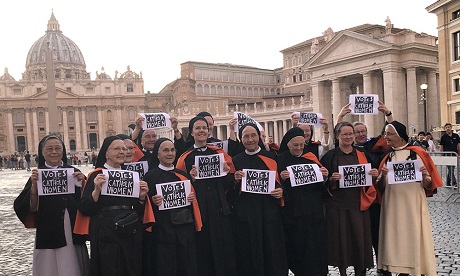It’s been nearly 14 centuries since the monastery founded by St Hild of Whitby, a prominent abbess in 7th century Anglo-Saxon England, hosted the Northumbrian kingdom’s assembly.
There they would discuss the date on which its Christian church would celebrate Easter.
That assembly, or synod, would bring the kingdom’s church in line with the Catholic Church in Rome.
“Scholars have long thought that Hild was a member of that synod,” said Katie Bugyis, an associate professor and trained medievalist in the program of liberal studies at the University of Notre Dame in South Bend, Indiana.
St. Hild notwithstanding, women have been shut out of decision-making at the Catholic Church’s highest levels.
That is, until Wednesday, when Pope Francis ordered unprecedented changes for the Vatican’s upcoming Synod of Bishops in Rome: For the first time, women will have a voice – and voting power – at the assembly, as will non-clergy believers.
“I like to think that Hild is still guiding this process,” Bugyis said.
‘A monumental and welcome step’
The pope’s changes to the church’s top deliberative body include inviting 70 non-bishop members to attend the October meeting, 10 from each of seven regional conferences worldwide.
The pope mandated that each delegation, picked from religious orders and communities, include five women; he also asked that young people be included.
Jamie Manson, president of Catholics for Choice, a group supporting Catholics calling for reproductive freedom, lauded the move.
“Pope Francis’s unprecedented decision to finally open the doors of the Synod of Bishops… to lay people is a monumental and welcome step toward a more just and inclusive church that listens to, reflects upon, and is guided by the wisdom and lived experiences of the people in the pews,” Manson said.
“I am deeply grateful to the Pope for making this much-needed change, and especially for his attention to ensuring that half of lay appointees are women.”
The move is significant given that among the discussion topics will be the role of women in the church, said Catherine O’Donnell, a professor of history at Arizona State University’s school of historical, philosophical and religious studies in Tempe.
At the same time, O’Donnell noted that the number of women empowered to speak and vote is relatively small. The synod’s 70 additional participants will represent less than a quarter of the 300 bishops who make up the bulk of attendees.
“My sense is this reflects Francis’ efforts to create a more inclusive Catholicism without directly disrupting the gendered architecture of the Church,” O’Donnell said.
It’s nonetheless a marked change from a synod conducted in 2019, when women’s religious orders were invited to attend as observers but not as voting members.
“That sparked a lot of criticism — maybe because it was so clearly just based on gender, not on a division between clergy and laity,” O’Donnell said. “This change matters.”
Move reflects pope’s track record
While it’s unclear how regional conferences will go about selecting their female and/or young participants, attendees “will be speaking as part of the process,” Bugyis said.
“They’re not just going to be silent observers…. I think it’s incredibly significant – but completely in keeping with Francis’ papacy up to this point.” Read more
- Marc Ramirez is career human interest/lifestyles journalist and wannabe food writer passionate about storytelling, culture and subculture, trendsetters and iconoclasts and stories about we live.
